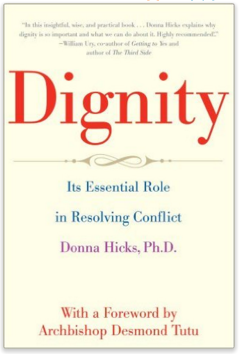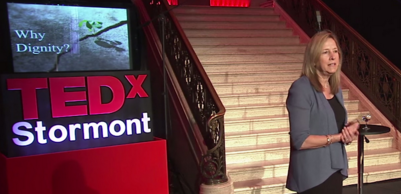How Dignity Resolves Conflict
“Our desire for connection is deep in our genes. We are living in a false state of alienation. The quality of our lives and our relationships could be vastly improved if we learned how to master the art and science of maintaining and honoring dignity.”
 Donna Hicks’ book Dignity: Its Essential Role in Resolving Conflict examines the powerful role of dignity in everyday lives and human conflict. Hicks’ book provides a concrete model for combatting shame and communicating honor in human relationships. Her ideas come from two decades in international conflict resolution and doctoral studies in psychology. This post offers a summary and analysis for our series “putting honor into action.”
Donna Hicks’ book Dignity: Its Essential Role in Resolving Conflict examines the powerful role of dignity in everyday lives and human conflict. Hicks’ book provides a concrete model for combatting shame and communicating honor in human relationships. Her ideas come from two decades in international conflict resolution and doctoral studies in psychology. This post offers a summary and analysis for our series “putting honor into action.”
Humans are hard-wired to avoid shame and demand dignity. Hicks cites neuroscience research how our brains process the threat of shame just like a physical wound. A threat to our worth jeopardizes our survival, so triggers our self-preservation instincts of fight-or-flight. (Hicks attributes this “primal desire for dignity” to our “shared evolutionary legacy,” though I believe humans’ innate compulsion for dignity was divinely implanted at creation.) Dignity is so fundamentally important to every human being, that any threat incites a strong, even violent, reaction. As great as our need for human connection is, we cannot stand to suffer indiginities. “People risk their lives to protect their honor and that of people in their social group; wars are fought over dignity threats.” (p. 14). Unfortunately this “epidemic of indignity worldwide” has received little attention.
When human worth is threatened during conflict, people experience “dignity violations.” This term is perhaps Hicks greatest insight. Rather than talking about shame (a topic nobody welcomes), Hicks proposes we frame conflict in terms of our dignity being violated. Using the language of dignity (instead of shame) for reconciliation allows people to speak about vulnerabilities and social injuries in non-demeaning terms. Moreover, this framework helps people assess themselves as dignity violators.
Understanding human conflict from this angle positions people to honor the dignity of others. Dignity is someone’s “inherent value and worth,” but that dignity is fragile and often trampled upon. When a relationship has been broken, a basic pathway forward is the affirmation of dignity in others. Learning to properly acknowledge and affirm the inherent dignity of other people is an acquired skill, not a natural inclination of the human heart. Nevertheless, it is essential for defusing the pain and conflict instigated by dignity violations.
To help readers “operationalize” the dignity model into practical actions steps, Hicks sets forth “10 Essential Elements of Dignity” (i.e., acceptance of identity, inclusion, safety, acknowledgement, recognition, fairness, benefit of the doubt, understanding, independence, and accountability) and “10 Temptations to Violate Dignity.” Though helpful reminders for conflict resolution, these points read like Enlightenment-based, pop morality at times.
 Overall, Hick provides a simple and compelling explanation of human dignity for peacemakers. Dignity violations incite conflict, and affirming dignity curbs conflict.
Overall, Hick provides a simple and compelling explanation of human dignity for peacemakers. Dignity violations incite conflict, and affirming dignity curbs conflict.
I’m thankful for Hicks’ practical and redemptive insights in the field of conflict resolution.

This sounds like a great read.
I teach that the basic Core Competencies of a Healing/Growth relationship are:
Genuineness
Respect
Empathy
Warmth
Research starting in the 50’s indicates that when these “Core Competencies” are present, the people around us get better. When they are missing people regress.